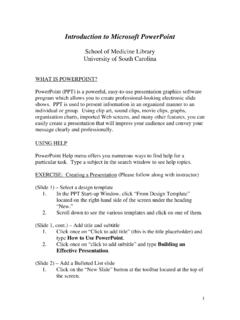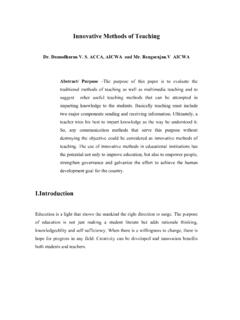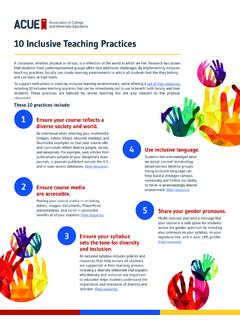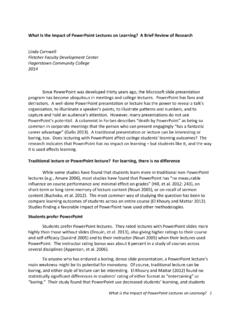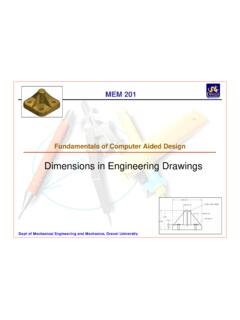Transcription of The Flipped Classroom. An Approach to Teaching and Learning
1 The Flipped Classroom. An Approach to Teaching and Learning July 2016 The Benjamin Center, SUNY New Paltz Ulster County School Boards Association2 Lynne Drake, Micaela Kayser, Robin JacobowitzThe Flipped Classroom. An Approach to Teaching and learningJonathan Bergmann and Aaron Sams, two chemistry teachers in Woodland Park, Colorado, needed to help students who had missed class - because of sickness, or varsity sports, or for other reasons - catch up on their school work. It was massively inefficient, in fact impossible, to try to teach each student each missed lesson, one at a time. So they decided to create a series of videos of their lectures for the absent students to watch at home. Word got out. Soon, Woodland Park students who had attended class began watching the videos for clarification as they worked on their homework assignments.
2 Then, educators and students from other districts found and used the videos as well. Watching all this, Sams realized that the videos could be used routinely to teach core course material the night before each class met, with class time the next day used to engage with students and ensure understanding; the conventional instructional model could be Flipped . More Teaching time was gained, and more effective Teaching and Learning achieved. The next school year, Bergmann and Sams began recording lectures for every class and every unit, flipping their classrooms completely (Bermann & Sams, 2012).Now, teachers across the country are making the decision to flip their class-rooms, offering short video lectures at home, and using class time for application of the material learned at home (Bishop & Verleger, 2013; Educuse, 2012; Herreid & Schiller, 2014).
3 In a Flipped classroom, students gain first exposure to new mate-rial outside of class, usually via reading or lecture videos, and then use class time to do the harder work of assimilating that knowledge, perhaps through problem-solving, discussion, or debates (Brame, 2013, p. 1). The Teaching / Learning effort thus becomes far more student centered and class time is meant for exploring topics in greater depth and creating richer Learning opportunities (Hamdan et al, 2013, p. 5). The change to the Flipped classroom takes time, effort, and commitment on the part of teachers and students. In this essay, A 2020 Vision for Public Education in Ulster County explores the phenomenon of the Flipped classroom and discusses its benefits and disadvantages, the resources necessary to make the flip, and the practical experience of some teachers as they transitioned to this new technique for Teaching and Learning .
4 3 BENEFITS OF THE Flipped CLASSROOMT hose of us who have gone through traditional school that s most of us - are familiar with the traditional, lecture-formatted classroom. In this model, class time requires multitasking; students listen to an instructor speak, process the new information being conveyed, and write down key ideas for future reference. However, there is research that suggests that this may not be the best mode of transmitting new material. According to Cognitive Load Theory, the working memory is limited in the amount of information it is able to process and store; when it is overwhelmed with information the process of Learning is disrupted (Hamdan, M., McKnight, P., McKnight, K., & Arfstrom, K., 2013). Flipping a classroom accounts for this problem by allowing students to learn new material at their own pace: they can pause the video to take notes and process information; they can rewind and review the video if there is something they do not understand (Educause, 2012; Bergmann & Sams, 2012).
5 With the lecture delivered, teachers can dedicate class time to the active integration of new knowledge. In the Flipped classroom model, class time is often used for student collaboration, skill development, presentations, problem solving all to foster a deeper understanding of content (Mazur, Brown, & Jacobsen, 2015). Teachers can engage with individual students, or groups of students, to ensure the material has been mastered. Dedicating classroom time to the practical application of content gives teachers more time to assist students who are struggling, which is particularly helpful because it allows teachers to witness mistakes students make as they are making them; teachers gain a better sense of students thought processes, which, in turn, enables them to better tailor instruction to assist that student (Houston & Lin, 2012).
6 Students who have mastered the material can move ahead with more complicated tasks and engage in work that extends their Learning (Herreid & Schiller, 2014). Finally, Flipped classrooms also have the unique characteristic of being able to educate parents alongside their children. Parents can watch the video lectures, thereby connecting them more closely to their child s education (Bergmann & Sams, 2012). CHALLENGES OF THE Flipped CLASSROOM The Flipped classroom model is heavily dependent on technology; students must have access to a computer (or similar device) and the internet so they can watch videos at home. Ensuring access to technology is the responsibility of educators. For students who do not have access at home, schools can increase the operating hours of computer labs at school or increase access to library computers.
7 Where possible, some schools might consider providing all students with their own personal electronic device with internet access. Likewise, teachers must have access to, and be comfortable with, technology that will allow them to record and edit videos, and then upload them to the internet so that they are accessible to students. Flipping a classroom requires considerable time and commitment on the part of the teacher. Planning, filming, and editing a quality video presentation is a time-consuming endeavor, especially for those not familiar with filming and editing technology. It takes time for teachers to become proficient with filming and editing equipment. In addition, striking the right tone and pace for a video presentation may take some experimentation. The engagement level of the videos is also critical; a lecture that is tedious in school will also be tedious on video.
8 Teachers who have successfully Flipped their classrooms state that the most promising videos are no more than 15 minutes long, depending on the age and attention-capacity of students, and often include some interaction between More Teaching time was gained, and more effective Teaching and Learning achieved. 4teachers (one teacher teaches, another asks questions) or interaction with a presentation format, such as Prezi or PowerPoint. In addition to spending time creating videos, teachers must also re-conceptualize how they will utilize classroom time to accommodate more active Learning . And then there are students responsibilities. Teachers who have Flipped their classrooms have found that they had to teach their students how to engage with the videos. At first, many students watched the videos quickly and without absorbing the information.
9 Teachers found that they had to demonstrate their expectations about video viewing. Some teachers use time during the first few days of school to watch a video with their class and demonstrate appropriate engagement with the video; how to take notes taking or rewind the video for clarification. Despite this effort, in some instances videos may go unwatched; just as with traditional homework assignments, some students will not complete them. Some teachers develop strategies to mitigate this, for example by requiring students to take a quick quiz when they come in to class the next day, or having students take notes on, or respond to questions in, the videos. Regardless, teachers must be prepared to deal with students who arrive to class unprepared, as class activities revolve around key components of the previous night s video.
10 As is true of all pedagogical approaches, the Flipped classroom may be implemented poorly. Flipping a classroom creates the potential for active, engaged, student-centered Learning , peer interactions, and personalized instruction. But none of this results automatically from moving direct instruction outside of the classroom. Teachers need to be committed to transforming their instruction and their use of classroom time. Students must develop self-management skills that allow them to engage with the videos and then be active learners in class. For teachers and students alike, the transition to a Flipped model takes time, effort, and commitment. TOOLS OF THE Flipped CLASSROOM: TECHNOLOGYT echnology is the primary tool of the Flipped classroom. As mentioned previously, students need access to technology to be able to watch videos at home; equally important is educators access to, and comfort with, the technology necessary to film, edit, and upload their videos.
